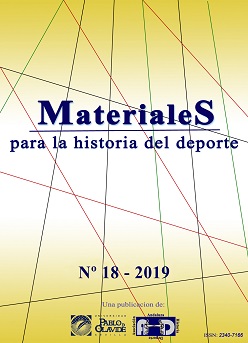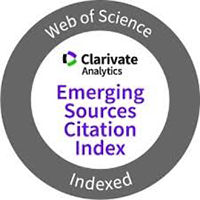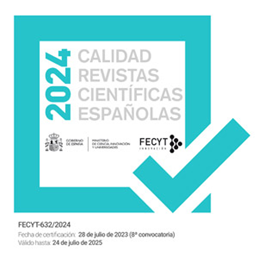Aproximación a la creación de valor en la industria deportiva: un enfoque conceptual
Palabras clave:
valor para el cliente, gestión del conocimiento, gestión deportiva, creación de conocimiento, capacidad de absorción.Resumen
Con el presente trabajo se pretende ayudar a los gestores de empresas deportivas a lograr mejores resultados en sus empresas. A partir de la creación de valor para los clientes las organizaciones deportivas van a lograr mejores resultados, y para ello, la gestión del conocimiento y, en concreto, la creación del mismo, se presenta como un antecedente de la creación de valor para el cliente. El presente trabajo contribuye a explicitar y a proponer cómo las organizaciones deportivas pueden mejorar sus resultados, por lo que se considera de especial interés para los directivos y gestores deportivos. La creación del conocimiento, a partir del proceso de capacidad de absorción, se convierte en un vehículo y antecedente para la creación de valor, y poder lograr mejores resultados y ventajas competitivas sostenibles para las empresas del sector deportivo. Este trabajo se propone como una propuesta conceptual, a partir de la revisión de la literatura anterior realizada por los autores que investigan sobre estas variables, para ser contrastada de modo empírico en un próximo estudio.
Descargas
Referencias
Alavi, M. y Leidner, D. E. (2001). Review: Knowledge management and knowledge management systems: Conceptual foundations and research issues, MIS Quarterly, 25 (1), 107-136.
Barney, J. (1991). Firm Resources and Sustained Competitive Advantage. Journal of Management, 17(1), 99-120.
Becerra-Fernandez, I. y Sabherwal, R. (2001). Organizational Knowledge Management: A Contingency Perspective. Journal of Management Information Systems, 18 (1), 23-55.
Bolton, R. N. y Drew, J. H. (1991). A Multistage Model of Customers' Assessments of Service Quality and Value. Journal of Consumer Research, 17 (4), 375-384.Chambers, S., y Cummins, R. (2009). Volunteering and its Relationship with Personal and Neighborhood Well-Being, Nonprofit and Voluntary Sector Quarterly, 38(1), 144-159.
Brown, J. S., y Duguid, P. (1998). Organizing knowledge. California management review, 40(3), 90-111.
Cassol, A., Gonçalo, C. R., y Ruas, R. L. (2016). Redefining the relationship between intellectual capital and innovation: The mediating role of absorptive capacity. BAR-Brazilian Administration Review, 13(4).
Cepeda-Carrion, G., Cegarra-Navarro, J. G., y Jimenez-Jimenez, D. (2012). The effect of absorptive capacity on innovativeness: Context and information systems capability as catalysts. British Journal of Management, 23(1), 110–129.
Chen, A. N., y Edgington, T. M. (2005). Assessing value in organizational knowledge creation: Considerations for knowledge workers. MIS quarterly, 279-309.
Chin, W. W. (1998). Commentary: Issues and opinion on structural equation modeling.
Cohen, W., y Levinthal, D. (1989). Innovation and learning: the two faces of R & D. The economic journal, 99(397), 569-596.
Cohen, W. y Levinthal, D. (1990). Absorptive capacity: a new perspective on learning and innovation. Administrative Science Quarterly, 35, 1, 128-152.
Cronin, J. J., Brady, M. K. y Hult, G. T. M. (2000). Assessing the Effects of Quality, Value, and Customer Satisfaction on Consumer Behavioral Intentions in Service Environments. Journal of Retailing, 76 (2), 193-218.
Davenport, T. H. y Prusak, L. (1998). Working Knowledge. Harvard Business School Press: Boston, MA.
Desarbo, W. S., Jedidi, K. y Sinha, I. (2001). Customer Value Analysis in a Heterogeneous Market. Strategic Management Journal, 22(9), 846-857.
Dodds, W. B., Monroe, K. B. y Grewal, D. (1991). Effects of Price, Brand, and Store Information on Buyers' Product Evaluations. Journal of Marketing Research, 28 (3), 307-319.
Droge, C., Calantone, R., y Harmancioglu, N. (2008). New product success: Is it really controllable by managers in highly turbulent environments? Journal of Product Innovation Management, 25(3), 272-286.
Drucker, P. F. (1985). Innovation and Entrepreneurship. Harper and Row: New York.
Drucker, P. F. (1993). Post-Capitalist Society. Harper Collins: New York, NY
Eisenhardt, K. M. y Martin, J. A. (2000). Dynamic Capabilities: What Are They? Strategic Management Journal, 21(10/11), 1105-1121.
Grant, R.M. (1991). The resource-based theory of competitive advantage: Implications for strategic formulation. California Management Review, 33 (3), 114-135.
Grant, R.M. (1996). Prospering in dynamically competitive environments: Organizational capability as knowledge integration. Organization Science, 7(4), 375–387.
Gazzera, M. A., y Martínez, E. E. V. (2018). El valor de los intangibles en las empresas prestadoras de servicios turísticos-caso hotelería en Toluca, México. Gestión Turística, 9-26. Holbrook, M. B. (1994). The Nature of Customer Value: An Axiology of Services in the Consumption Experience. In Rust, R. y Oliver, R. L. (Eds.), Service Quality: New Directions in Theory and Practice (pp. 21–71). Thousand Oaks, CA: Sage Publications.
Hooley, G. J., Greenley, G. E., Cadogan, J. W., y Fahy, J. (2005). The performance impact of marketing resources. Journal of business research, 58(1), 18-27.
Huysman, M. y Wulf, V. (2006). IT to Support Knowledge Sharing in Communities, Towards a Social Capital Analysis. Journal of Information Technology, 21 (1), 40-51.
Ipe, M. (2003). Knowledge Sharing on Organizations: A Conceptual Framework. Human Resource Development Review, 2 (4), 337-359.
Jansen, J. J., Van Den Bosch, F. A., y Volberda, H. W. (2005). Managing potential and realized absorptive capacity: how do organizational antecedents matter?. Academy of management journal, 48(6), 999-1015.
Kang, M., y Lee, M. J. (2017). Absorptive capacity, knowledge sharing, and innovative behaviour of R&D employees. Technology Analysis & Strategic Management, 29(2), 219-232.
Käpylä, J., Laihonen, H., Lönnqvist, A., y Carlucci, D. (2011). Knowledge-intensity as an organisational characteristic. Knowledge Management Research & Practice, 9(4), 315-326.
Karpen, I. O., Bove, L. L., y Lukas, B. A. (2012). Linking service-dominant logic and strategic business practice: A conceptual model of a service-dominant orientation. Journal of Service Research, 15(1), 21-38.
Karpen, I.O., Bove, L.L., Lukas, B.A. y Zyphur, M.J (2015). Service-Dominant Orientation: Measurement and impact on performance outcomes. Journal of Retailing, 91 (1), 89-108.
Kim, L. (1998). Crisis construction and organizational learning: capability building in catching-up at Hyundai Motor. Organization Science, 9, 506–521.
Kumar, V., y Reinartz, W. (2016). Creating enduring customer value. Journal of Marketing, 80(6), 36-68.
Lane, P. J., y Lubatkin, M. (1998). Relative absorptive capacity and interorganizational learning. Strategic Management Journal, 19, 461-477.
Lane, P. J., Salk, J. E., y Lyles, M. A. (2001). Absorptive capacity, learning, and performance in International Joint Ventures. Strategic Management Journal, 22, 1139-1161.
Lane, P. J., Koka, B. R., y Pathak, S. (2006). The reification of absorptive capacity: A critical review and rejuvenation of the construct. Academy of Management Review, 314), 833-863.
Lee, S. M. y Hong, S. (2002). An Enterprise-Wide Knowledge Management Infrastructure. Industrial Management & Data Systems, 102(1), 17-25.
Liao, S. H., Wu, C. C., Hu, D. C., y Tsui, K. A. (2010). Relationships between knowledge acquisition, absorptive capacity and innovation capability: an empirical study on Taiwan’s financial and manufacturing industries. Journal of Information Science, 36(1), 19-35.
Macintosh, A. (1997). Position Paper on Knowledge Management, Artifitial Intelligence Applications Institute, University of Adinburgh, marzo, 1997.
Martelo-Landroguez, S., Barroso, C., y Cepeda, G. (2011). Creating dynamic capabilities to increase customer value. Management Decision, 49(7), 1141–1159.
Mizik, N. y Jacobson, R. (2003). Trading Off between Value Creation and Value Appropriation: The Financial Implications of Shifts in Strategic Emphasis. Journal of
Marketing, 67 (1), 63-76.
Mocciaro, A. y Battista, G. (2005). The Development of the Resource-Based Firm between Value Appropriation and Value Creation. Advances in Strategic Management, 22, 153-188.
Morrow Jr, J. L., Sirmon, D. G., Hitt, M. A., y Holcomb, T. R. (2007). Creating value in the face of declining performance: Firm strategies and organizational recovery. Strategic management journal, 28(3), 271-283.
Mowery, D.C, y Oxley, J. E. (1995). Inward technology transfer and competitiveness: The role of national innovation systems. Cambridge Journal of Economics, 19, 67-93.
Nonaka, I. (1991). The knowledge-creating company. Harvard Business Review, November-December, 96-104.
Nonaka, I. y Takeuchi, H. (1995). The Knowledge Creating Company. Oxford University Press, New York.
Parasuraman, A., Zeithaml, V., y Berry, L. (1985). A Conceptual Model of Service Quality and its Implications for Future Research. Journal of Marketing, 49(4), 41-50.
Pentland, B. T. (1995). Information systems and organizational learning: the social epistemology of organizational knowledge systems. Accounting, Management and Information Technologies, 5(1), 1-21.
Peteraf, M. A. (1993). The Cornerstones of Competitive Advantage: A Resource-Based View. Strategic Management Journal, 14 (3), 179-191.
Porter, M. E. (1985). Competitive Advantage Creating and Sustaining Superior Performance. New York: The FreePress.
Rezgui, Y. (2007). Knowledge Systems and Value Creation. Industrial Management & Data Systems, 107 (2), 166-182.
Sánchez, R., Iniesta, M. A. y Holbrook, M. B. (2009). The Conceptualisation and Measurement of Consumer Value in Services. International Journal of Market Research, 51 (1), 93-113.
Schiuma, G., Carlucci, D., y Lerro, A. (2012). Managing knowledge processes for value creation. Vine, 42(1), 4-14.
Serenko, A. y Bontis, N. (2004). Meta-Review of Knowledge Management and Intellectual Capital Literature: Citation Impact and Research Productivity Rankings. Knowledge and Process Management, 11 (3), 185-198.
Slater, S. F. y Narver, J. C. (1998). Customer-Led and Market-Oriented: Let's Not Confuse the Two. Strategic Management Journal, 19(10), 1001-1006.
Smith, J. B. y Colgate, M. (2007). Customer Value Creation: A Practical Framework. Journal of Marketing Theory & Practice, 15 (1), 7-23.
Spender, J. C. y Scherer, A. G. (2007). The Philosophical Foundations of Knowledge Management: Editors' Introduction. Organization, 14 (1), 5-28.
Spiteri, J. M. y Dion, P. A. (2004). Customer Value, Overall Satisfaction, End-User Loyalty, and Market Performance in Detail Intensive Industries. Industrial Marketing Management, 33 (8), 675-687.
Sweeney, J. C., Soutar, G. N. y Johnson, L. W. (1999). The Role of Perceived Risk in the Quality-Value Relationship: A Study in a Retail Environment. Journal of Retailing, 75 (1), 77-105.
Teece, D. J., Pisano, G. y Shuen, A. (1997). Dynamic Capabilities and Strategic Management. Strategic Management Journal, 18(7), 509-533.
Tirpak, T. M. (2005). Five Steps to Effective Knowledge Management. Research Technology Management, 48 (3), 15-16.
Van den Bosch, F. A. J., Volberda, H. W. y De Boer, M. (1999). Coevolution of Firm Absorptive Capacity and Knowledge Environment: Organizational Forms and Combinative Capabilities. Organization Science, 10 (5), 551-568.
Van den Hooff, B. y Huysman, M. (2009). Managing Knowledge Sharing: Emergent and Engineering Approaches. Information & Management, 46 (1), 1-8.
Wang, Y., Lo, H. P., Chi, R. y Yang, Y. (2004). An Integrated Framework for Customer Value and Customer-Relationship-Management Performance: A Customer-Based Perspective from China. Managing Service Quality, 14 (2/3), 169-182.
Woodruff, R. B. (1997). Customer Value: The Next Source for Competitive Advantage". Journal of the Academy of Marketing Science, 25 (2), 139-153.
Yildiz, S.M. y Kara, A. (2012), “A re-examination and extension of measuring perceived service quality in Physical Activity and Sports Centres (PSC): QSport-14 scale”, International Journal of Sports Marketing and Sponsorship, Vol. 13 No. 3, pp. 26-45
Zander, U. y Kogut, B. (1995). Knowledge and the speed of the transfer and imitation of organizational capabilities: An empirical test. Organization Science, 6 (1), 76-91.
Zahra, S.A. y George, G. (2002). Absorptive capacity: A review, reconceptualization, and extension. Academy of Management Review, 27(2), 185-203.
Zeithaml, V. A. (1988). Consumer Perceptions of Price, Quality, and Value: A Means-End Model and Synthesis of Evidence. Journal of Marketing, 52(3), 2-22.
Wang, J., y Wang, X. (2012). Structural Equation Modeling Applications Using Mplus. Chichester: John Wiley & Sons Ltd.
Descargas
Publicado
Número
Sección
Licencia
Aquellos autores/as que tengan publicaciones con esta revista, aceptan los términos siguientes:- Los autores/as conservarán sus derechos de autor y garantizarán a la revista el derecho de primera publicación de su obra, el cuál estará simultáneamente sujeto a la Licencia de reconocimiento de Creative Commons que permite a terceros compartir la obra siempre que se indique su autor y su primera publicación esta revista.
- Los autores/as podrán adoptar otros acuerdos de licencia no exclusiva de distribución de la versión de la obra publicada (p. ej.: depositarla en un archivo telemático institucional o publicarla en un volumen monográfico) siempre que se indique la publicación inicial en esta revista.
- Se permite y recomienda a los autores/as difundir su obra a través de Internet (p. ej.: en archivos telemáticos institucionales o en su página web) antes y durante el proceso de envío, lo cual puede producir intercambios interesantes y aumentar las citas de la obra publicada. (Véase El efecto del acceso abierto).













